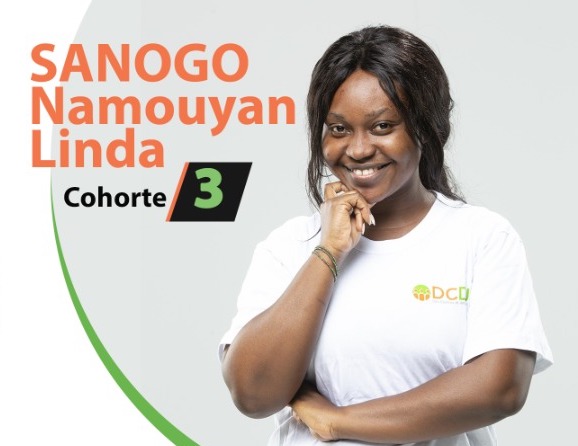
Empowering Counselors and Social Workers with Rapid Access to Patient Information
Linda Sanogo, a DCDJ Fellow in Côte d’Ivoire, worked with a community health facility to develop and train staff on a new database, as well as complete training on other IT systems. Because of Linda’s support, the facility has reduced the number of hours spent managing patient records, and opened up more time to ensure high-quality care.
Background
The Des Chiffres et Des Jeunes (DCDJ) Data Fellowship is a flagship DCDJ program that places technically-trained Ivorian youth into organizations where they encourage and increase the degree to which data is used for decision making. It is a unique opportunity for young people to sharpen data skills while contributing to a strengthened data ecosystem and to data-related resource availability in Côte d’Ivoire. DCDJ is led by Development Gateway and funded by the Data Collaboratives for Local Impact (DCLI) program. The DCDJ Data Fellowship builds young peoples’ skills to strategically catalyze sustainable change, DCDJ leverages local capacity to improve data access, sharing, and availability.
Prior to becoming a fellow, Linda was in an IT training program. She was particularly interested in learning more about how data science could be used in her daily and professional life.
Problem
After the intensive DCDJ Data Fellowship training, Linda’s internship placement was at a community health facility in Port-Bouet Gonzaqueville. She noticed that the health facility was generally well run, but that there were opportunities to improve maintenance of proper patient records. Two issues converged to result in poor quality data:
- The facility had 1024 active patient records, with 25 to 60 new patients – and patient records – added each month. These records were kept in paper files. Every day, the social workers, counselors, and other staff would need to ask the Data Manager to pull information from the 30 records for the patients they would be seeing. Records were not always easy to locate, and sometimes patients would be told to come back another day once their record was located. In addition, all record updates had to go through the Data Manager, which could take several extra days.
- The second issue Linda saw was that despite having a computer system at the facility, the counselors and social workers were “afraid to even turn the computers on,” and did not feel that they had enough technical knowledge to use them.
Solution
Linda understood that the social workers and counselors were undertaking a huge amount of work that truly impacts the lives of people in the community. At the same time, the way the health facility was maintaining records was creating additional work. The solution Linda developed was two-fold, first to create an electronic database of patient records that would be easy for staff to use – and that connected to the larger SIGDEP2 system which manages the country’s patient-level HIV data; and second to train the staff to use both the new database and SIGDEP2.
Process
In training staff that had such little experience using computers, Linda started with the basics – how to turn the computer on, what types of programs were available, and how to search for information on the internet. She trained four female staff members (counselors and social workers) in these basic skills. Then, working with the Data Manager at the facility, she developed an Excel database that interfaced with the SIGDEP2 system. Linda continued to expand training for the women to include both the new database and SIGDEP2. There was hesitancy at first as the women did not see how computer skills or the new databases would be useful in their work. However, after some time and guided training strategies, they became comfortable with the systems and saw how easy it was to pull up information on the patients they would be seeing on a given day; for example, they could easily find out if a patient was up to date on his medication or needed a new prescription. With these skills, the women healthcare administrators at the community center could become more confident in their work, boost their efficiency, and grow their careers – contributing to an important increase in women in data science.
Outcomes and Impacts
Four additional staff are now trained and using the new systems. The new systems make the counselors and social workers more autonomous. They are now comfortable searching the database and SIGDEP2 directly for needed information rather than going through the data manager. The time saved by staff goes to ensuring better quality patient care and making sure that patients are supported and do not lose track of their appointments or become marked as “Interruption in Treatment (IIT).”
Additionally, Linda’s work had an even larger impact on the overall data ecosystem. Now instead of waiting days for physical records, or having to go through the Data Manager, staff can use the available databases to find the information they need. The Data Manager now spends less time pulling records for other staff and can put more time into ensuring quality records and managing the system. With SIGDEP2 and Linda’s database in place, the facility can now see which tasks are most challenging and time-consuming, and can adapt their internal processes to be more efficient.
Conclusion
Linda’s passion for data science has stayed with her after the DCDJ Fellowship. Now she works in a private IT company, where she is using data science to track incident reports. Her new company is realizing that tracking and using the data from incident reports has created a more efficient allocation of technicians – and also has started investing in data science as a result. Of the DCDJ experience, she said, “If it were up to me, all young people would be trained in data science!”



